Chevrolet Citation
The Chevrolet Citation is a range of compact cars that was produced by the Chevrolet division of General Motors. The first Chevrolet sold with front-wheel drive, a single generation of the Citation was sold from the 1980 to 1985 model years, succeeding the Chevrolet Nova. The model range was offered in three body styles: three-door and five-door hatchbacks and a two-door notchback coupe.[1]
| Chevrolet Citation | |
|---|---|
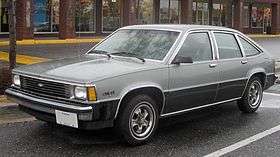 1984-1985 Chevrolet Citation II 5-door | |
| Overview | |
| Manufacturer | General Motors |
| Production | 1979–1985 |
| Model years | 1980–1985 |
| Assembly | Oklahoma City, Oklahoma, U.S. North Tarrytown, New York, U.S. Ramos Arizpe, Mexico |
| Body and chassis | |
| Class | Compact |
| Body style | 2-door notchback 3-door hatchback 5-door hatchback |
| Layout | Transverse front-engine, front-wheel drive |
| Platform | X-body |
| Related | Buick Skylark Pontiac Phoenix Oldsmobile Omega |
| Powertrain | |
| Engine | 2.5 L Iron Duke I4 2.8 L LE2 V6 2.8 L LH7 HO V6 2.8 L LB6 MPFI V6 |
| Transmission | 3-speed TH-125 automatic 4-speed manual |
| Dimensions | |
| Wheelbase | 104.9 in (2,664 mm) |
| Length | 176.7 in (4,488 mm) |
| Width | 68.3 in (1,735 mm) |
| Height | 53.9 in (1,369 mm) |
| Chronology | |
| Predecessor | Chevrolet Nova |
| Successor | Chevrolet Corsica Chevrolet Beretta |
The Citation was built on the second-generation compact GM X-platform. For 1980, the platform was switched to front-wheel drive and significantly downsized (nearly reducing its exterior footprint to that of the 1970s H-platform subcompacts). The Citation was sold alongside the Pontiac Phoenix, Buick Skylark, and Oldsmobile Omega; while the Phoenix was also produced as a hatchback and the Skylark and Omega were produced as two-doors, the two-door notchback coupé body was exclusive to the Citation. Alongside a standard trim level, Chevrolet offered the Citation X-11, offering performance-oriented upgrades.
In an extended 1980 model year, over 800,000 examples of the Citation were sold; along with becoming the best-selling car in the United States for the model year, the Citation was among the most successful product launches in General Motors history.[2] After the 1981 model year, sales of the Citation significantly decreased as the launches of the Chevrolet Cavalier and Chevrolet Celebrity expanded the front-wheel drive Chevrolet product range. After the 1985 model year, Chevrolet discontinued the Citation, replacing the model line with the Chevrolet Beretta two-door coupe and Chevrolet Corsica four-door sedan/five-door hatchback. In total, Chevrolet manufactured 1,642,587 examples of the model line during its production run.[2]
Development
To better compete in the compact segment following the 1973 fuel crisis, General Motors commenced work in April 1974 on a replacement for its X-body compact lines, including the Chevrolet Nova. As the 1970s progressed, import-brand compact cars continued to grow in popularity, gaining sales from domestic counterparts. Largely serving as a second generation of the Chevrolet Vega, the Chevrolet Monza proved relatively successful, though inefficient and outdated in comparison to front-wheel drive compacts such as the Honda Accord and the Volkswagen Rabbit (the layout of the latter was nearly copied outright by Chrysler to develop the 1978 Dodge Omni/Plymouth Horizon).
While GM had produced front-wheel drive vehicles for nearly a decade, its experience involved large personal luxury coupes (Cadillac Eldorado and Oldsmobile Toronado) and recreational vehicles (GMC Motorhome), neither fuel-efficient nor compact. Following the reverse-engineering of Lancia vehicles, GM selected a transverse front-wheel drive layout for the new X-body[3]; in the mid-summer of 1976, the first vehicle prototypes entered testing; in its development, Chevrolet would design the front suspension of the platform, with Pontiac responsible for the rear.[3]
Intended for a 1978 model release, the Chevrolet Nova replacement was to adopt the "Condor" nameplate. Coinciding with the downsizing of the A-body mid-size line for 1978, the launch of the Chevrolet Condor was moved to 1980, as GM parts suppliers were trying to adjust to large-scale production of a front-wheel drive car. During the delay, the Chevrolet Condor name was scrapped in favor of Chevrolet Citation.[4]
History
Along with its debut as the first front-wheel drive Chevrolet, the Citation also marked the downsizing of the Chevrolet compact model line (following the downsizing of the 1977 Caprice/Impala and 1978 Malibu). While packaged with similar interior space as the Malibu and trunk space as the Impala[5], the Citation shed 20 inches of length (only an inch longer than a Vega), 4 inches of width, and 800 pounds of weight from the 1979 Nova.
Through its production, as one of the front-wheel drive X-body vehicles, the Chevrolet Citation would undergo a number of manufacturer recalls. In 1980, 225,000 examples were recalled to fix a transmission hose related to underhood fires.[2][6] The X-body cars (which included the Citation) were the target of an unsuccessful lawsuit by the U.S. National Highway Traffic Safety Administration (NHTSA), which cited a tendency for the vehicles to lose control under heavy braking, and power steering problems.
1980
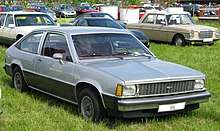
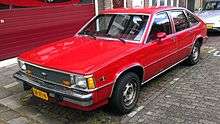
In April 1979, the Citation was released as a 1980 model in two trim levels. Alongside the standard trim, a sporty X-11 version was produced.[1]
Priced under US$6,000, with hatchbacks in a much larger package than the Dodge Omni/Plymouth Horizon, demand proved very high for the Citation. Helped by an April release and yet another gasoline shortage during the same time, over 800,000 Citations were sold by Chevrolet for the model year. However, as the second gas crisis created demand for more fuel-efficient vehicles, GM was left with significant shortages of 4-cylinder engines, leaving some customers to wait several months to receive their vehicles. Before the fuel crisis, Chevrolet had anticipated 70% of customers purchasing the V6 engine option, leading to production lines unable to keep up with demand for four-cylinder models.
In an extended 1980 model year, Chevrolet would sell over 810,000 examples of the Citation; in addition to making for one of the most successful product launches in General Motors history, the Chevrolet Citation would become the best-selling car in the United States in 1980.[1]
1981
For 1981, while the Citation saw no visible changes, the model line was pared down, with the two-door coupe discontinued (in response to slow sales).[2] The X-11 gained additional performance, as the model received a 135-hp high output version of its 2.8L V6.[2]
In 1981, the Chevrolet Citation gained its most direct competitor, as Chrysler introduced the Dodge Aries/Plymouth Reliant (the Chrysler K-Cars). While also produced in front-wheel drive, the K-Cars offered sedan and station wagon body styles unavailable from Chevrolet.
1982
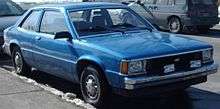
For 1982, fuel injection was added to the 2.5L engine; to further increase fuel economy, low rolling resistance tires were added to all Citations (including the X-11).[7] As a running change during the year, the two-door notchback (coupe) made its return after being dropped for 1981.[7]
Chevrolet introduced two models for 1982 that would produce a significant effect on Citation sales. Phased in to replace the Malibu, the Chevrolet Celebrity was an A-Body vehicle. While sharing its wheelbase and powertrain with the Citation, the sedan and wagon bodies of the Celebrity were considered mid-size cars. Replacing the Monza, the Chevrolet Cavalier J-body subcompact further expanded the front-wheel drive product offering with its own coupe, hatchback, and station wagon competing closely against the Citation.
The Citation, Celebrity, and Cavalier were sold with Buick, Oldsmobile, and Pontiac counterparts (the latter was also sold as a Cadillac).
1983
For 1983, few external changes were made to the Citation, while several revisions were made to the interior.[8] The dash underwent minor trim updates for the first time since 1980, with the front seats receiving adjustable head restraints.[8] The X-11 package returned to the two-door coupe (for the first time since 1980), while its HO V6 became an option on all Citations.[8]
1984
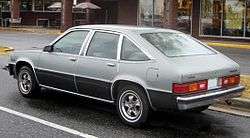
For 1984, the Citation was renamed the Citation II.[9] While undergoing almost no visible changes outside of badging, the rebranding was intended to draw attention away from previous recalls and quality issues.[6][9] All three body styles remained, along with the X-11.
For the first time, Citation sales increased over the previous year (though remaining under 100,000).[9]
1985
For 1985, the Citation II saw several revisions in its final year of production. The two-door Citation II was discontinued for good, though the X-11 remained.[9] The dashboard underwent a redesign with a horizontally-mounted radio and a new steering wheel.[9] The 2.8L HO engine became fuel injected (reducing output to 130 hp).[9]
The last Citation rolled off the assembly line on June 21, 1985.
Powertrain
In addition to the X platform, GM also created a new line of engines for the Citation and its sisters. The 2.8 L LE2 V6 was the first of the 60°Family of engines. The X platform was used in 1982 as the basis for the new front-wheel drive A-body cars. The X platform was also the basis for the future L-body and N-body cars.
X-11
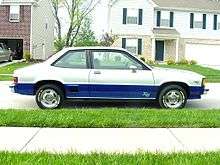
Produced as a separate trim level, the Citation X-11 was a variant featuring cosmetic, chassis, and powertrain upgrades over the standard Citation. While less powerful than the Camaro Z28 (and later Monte Carlo SS), the Citation X-11 would also take over the role of the similarly-sized Chevrolet Monza. The X-11 was offered throughout the production run of the Citation/Citation II, on the 3-door hatchback and 2-door "club coupe" (discontinued in 1981 and 1985).
In 1981, the Citation X-11 accelerated from 0–60 MPH in 8.5 seconds; the 1982–1984 version accelerated from 0–60 MPH in 9.2 seconds.
Chassis upgrades
At its 1980 launch, the chassis of the Citation X-11 was upgraded with front and rear stabilizer bars and a retuned sport suspension, which were kept throughout its production. In place of steel wheels, the X-11 featured 13-inch rallye rims with Goodyear P205/70R-13 white-letter tires. In 1981, the 13-inch wheels were replaced with 14-inch wheels with Goodyear Eagle GT P215/60 R14 radial tires. To upgrade handling, for 1982, the steering rack was relocated from the firewall to the subframe holding the engine and front suspension. The design change was intended to prevent subframe movement from affecting steering behavior.
For 1980, the X-11 offered only handling upgrades over a Citation, with the powertrain consisting of a 90hp 2.5L inline-4 and a 115hp 2.8L V6.[2] Alongside the standard Citation, the X-11 was available with either a 4-speed overdrive manual transmission or a 3-speed automatic transmission (the only transmission available for 1985).
To aid acceleration, axle ratios of the X-11 were changed, alongside the transmission gearing. A taller first gear was intended to allow the X-11 to accelerate to 60 mph without shifting to third gear. For 1981, the X-11 was powered exclusively by a "high-output" version of the 2.8L V6; a higher-performance dual-tip exhaust system raised output to 135hp/165lb-ft of torque. As before, the X-11 maintained separate final-drive ratios.[2] In 1982, emissions regulations required a decrease in torque output, to 145 lb-ft (horsepower remained unchanged). This output remained the same through 1984. In 1985, the carbureted engine was replaced by a fuel-injected version of the 2.8L V6 with output decreased to 130hp/155lb-ft of torque. In slightly different tuning, the Citation X-11 shared its powertrain with the Chevrolet Celebrity Eurosport, Pontiac 6000STE, and Pontiac Fiero.
Body upgrades
In 1980, the Citation X-11 shared most of its powertrain with the standard Citation, with the model being mostly a chassis and visual upgrade. Alongside the alloy wheels and tires, the X-11 featured a trunklid spoiler, sport mirrors, body skirting, and side striping. In 1981, to better distinguish the model from standard two-tone Citations, the side striping of the X-11 was replaced in favor of large "X-11" door graphic, which remained in use for the rest of its production. The model is best distinguished from a standard Citation by its use of a black grille (the only exterior chrome trim on a Citation II X-11 is the Chevrolet grille bowtie and trunklid badging). In 1981, a functional cowl-induction hood scoop was added. Under hard acceleration, a solenoid operated switch opened a flap that let in extra air.
While produced without the front bench seat seen in the launch of the Citation, the interior of the X-11 was most widely differentiated with the use of a sport steering wheel. The X-11 was produced with its own instrument panel, which featured a full set of engine gauges (6000 RPM tachometer for 1980, 7000 RPM tachometer for 1981–1985).
Racing
The SCCA classified the X-11 in Showroom Stock B class. Bob McConnell drove a 1981 X-11 to SSB National Championships in 1982 and 1984.
Awards
The Chevrolet Citation was awarded Motor Trend Car of the Year for 1980. In 2009, the editorial staff of Car and Driver criticized the 1980 Motor Trend decision (alongside several other vehicle awards[10]), citing poor build quality and mechanical reliability undeserving of such an award in hindsight.[10]
Car and Driver, along with several other car magazines of the time, were duped when GM lent them specially modified versions of the X-body vehicles in which heavy torque steer had been engineered out (torque steer was a handling trait common to X-platform vehicles). Patrick Bedard of Car and Driver said that they were completely surprised by this when they drove a production version some time later.[11] Like the other X-body cars, the Citation was plagued by numerous reports of a tendency to lock the rear wheels upon braking, causing it to lose control and crash.
Sales
| Chevrolet Citation production[2] | |
|---|---|
| Year | Sales |
| 1980 | 811,540 |
| 1981 | 413,379 |
| 1982 | 165,557 |
| 1983 | 92,184 |
| 1984 | 97,205 |
| 1985 | 62,722 |
References
- "Chevrolet Citation". HowStuffWorks. 2007-08-02. Retrieved 2020-02-07.
- The Auto Editors of Consumer Guide. "Chevrolet Citation". HowStuffWorks.com. Retrieved 2010-01-23.
- "GM's X-Cars: Anatomy of a Miserable Failure | Automobile Magazine". Automobile. 2019-05-21. Retrieved 2020-02-07.
- "Chevrolet Citation (thing) by schizophasic - Everything2.com". everything2.com. Retrieved 2015-11-14.
- KY; https://www.dancummins.com/wp-content/themes/DealerInspireDealerTheme/images/logo.png, 40361 United States 877-661-2805. "Remembering the Chevy Citation | Dan Cummins". Dan Cummins Chevrolet Buick. Retrieved 2020-02-07.
- "Citation - Model Information". conceptcarz.com. Retrieved 2020-02-07.
- "Chevrolet Citation". HowStuffWorks. 2007-08-02. Retrieved 2020-02-07.
- "Chevrolet Citation". HowStuffWorks. 2007-08-02. Retrieved 2020-02-07.
- "Chevrolet Citation". HowStuffWorks. 2007-08-02. Retrieved 2020-02-07.
- "Dishonorable Mention: The 10 Most Embarrassing Award Winners in Automotive History". www.caranddriver.com. Retrieved 2012-06-29.
- "The Skeptic has a Malibu Moment – Column – Auto Reviews". Car and Driver. Archived from the original on 2011-06-09. Retrieved 2010-05-01.